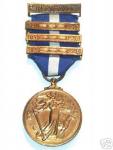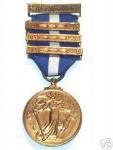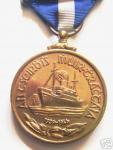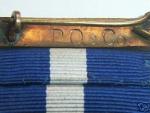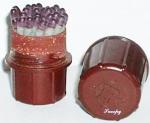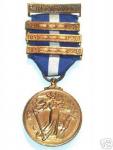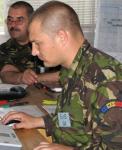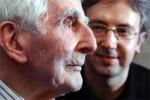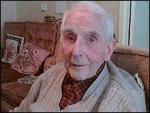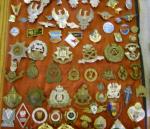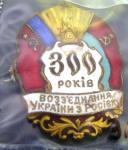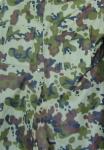-
Posts
9,099 -
Joined
-
Last visited
-
Days Won
4
Content Type
Profiles
Forums
Blogs
Gallery
Events
Store
Everything posted by Kev in Deva
-
Hallo Gents might sound like a daft question, but can any member put a figure to how many Prussian /German Officers of Jewish origin served in WW1. Was there a campaign against them / were they viewed with mistrust? The reason I ask is hopefully the answers will blow away another myth with regards their service being small and menial. If you would care to post figures for the Allies as well please do. Kevin in Deva.
-
Hallo Alex K, I believe it was down to individual makers / tailors, the hooks and clasp vary as well, the one on the right looks more astehtic by having most of the hook hidden. Kevin in Deva.
-
Hallo Ulsterman thanks for the link, while the buckle probably has a connection to the old IRA I feel its post 1916 Rising, the Easter Rising was a hastely planned event, and not sanctioned by all the IRA leaders, I dont think they were making Buckles with reference to the Provisional Government prior to the Rising, I have never heard mention of Buckles for uniforms at that time, seeing as the British & R.I.C, were very active in searching for IRA members the buckle would have been a dead give away. The medal pictures are not great on her auctions, the detail is poor, as for reference to her Grandfather (who she will show a picture of, but not mention the family name ?? why not, there is no stigma attached to the men of this time.) Kevin in Deva
-

Interesting Article in Today's Boston Globe
Kev in Deva replied to buellmeister's topic in Firearms & Ordnance
Hallo Joel, Is this not a RARE circumstance? just how many Librarians find machine-guns in the attic, every day in the USA. Kevin in Deva -

Restoring gold
Kev in Deva replied to Rod's topic in Preservation & Restoration of Military Artifacts
Hallo Gents, Solid Gold! surely too soft to be used in anything, thats why its mixed with other alloys to make it durable in the manufacture of items. Kevin in Deva -
Hallo Alex, personaly I am for leaving it alone, as repairs never can match the original, unless you want to chip off all the remaining original enamel and start from scratch Kevin in Deva.
-

Unknown (to me) North Korean badge ?
Kev in Deva replied to Kev in Deva's topic in South East & East Asia
Hallo usairforce thanks for your post, "Excellent Company" as in a military unit? And can you give an approximate value? Thank you, Kevin in Deva -
Hallo Gents, Medal Comparison Pictures: f78b_1_b Auction Medal from seller: "billysmarket" 18. April 07. sold for GB 2,250.01 fdb8_1 Current Auction Picture from seller: "ireldna" fb73_1 Rear view: "billysmarket": fdfa_1 Rear view: "ireldna" fe02_1 00b6_1 Suspension detail and Designer name detail shown on the original auction by "billysmarket". The seller "ireldna" has not posted pictures of the suspension or Maker details on their auction!!! Notice also the similarity with the picture titles / numbers, except 1. I got an email reply via ebay that close-up pictures of the reverse would be sent today by seller "ireldna" Call me paranoid but, methinks something is a bit fishy about this second auction Kevin in Deva
-

Luftwaffe Lw matchbox
Kev in Deva replied to Snoopy's topic in Germany: Third Reich: Uniforms, Headwear, Insignia & Equipment
Hi Snoopy Even highlighted its hard to define the logo can you take a picture of just the top of the lid, or scan same? Thanks Kevin in Deva -
Hallo Jacky the clasp / bar represent periods of service. Medal without bar to men who served on Irish Registered Ships for at least six months, but less than two years, (299 issued). Medal with one bar for two years service, (122 issued.) Medal with two bars for 4 years service, (34 issued.) Medal with three bars for six years service between September 3, 1939 to March 31st, 1946. (58 Issued.) There was a special certificate for men who served less than six months. As the bar is identical to the bars on the other Irish "Emergency Service" * Medals (Army, Reserve, Air-Raid, Red Cross etc) its very easy for bars to be added to a Merchant Marine Medal to upgrade it. Compounding the problem is the fact none of the medals issued were named, in the absence of irrefutable provenance, collectors should treat multi-bar medals with a good deal of caution * Ireland was Neutural in WW2 however her Merchant ships were attacked from the air, by sea-mines and by U-boats, incuring casualties**, WW2 is known in Ireland as "The Emergency". *+ 16 ships were lost, and although no more than 800 men were in service at any one time, 135 were killed and 14 wounded. They also managed to rescue 511 men of all nationalities in the course of their journeys. This medal for the Merchant Marine while similar in many respects to the other Emergency Service medals, but was a gift from the Department of Industry and Commerce, rather than the Department of Defence. Kevin in Deva.
-

Fake Axis Entry into Afrika medal Fake
Kev in Deva replied to Alex K's topic in Wehrmacht Medals, Decorations & Awards
Hallo Alex, even if it turns out to be a dud ( I sincerely hope not) its better to hang onto it for reference purposes and also to post pictures with relavent info in the FAKE section of the forum, we all get stung, my dud was a Luft Para Badge bought in Germany a few years ago. Kevin in Deva -

Romania Communist Romania Prison Officer Tunic.
Kev in Deva replied to Kev in Deva's topic in Central & Eastern European States
Hallo Gordon thanks for your comments, while outside my collecting field I just hate to see stuff getting dumped, Romanian Communist items such as uniforms are not so often found and even with fair "wear and tear" are a record of the past. For example its virtually impossible to find items of WW1 & WW2 uniforms. especially belonging to the lower ranks, as these items have been "recycled" through the working-class population on the farms etc.. and worn into rags Eventually I will put them up for sale as they take up to much space, and my passion (after the wife ) are medals and decorations. Kevin in Deva -

Fake Axis Entry into Afrika medal Fake
Kev in Deva replied to Alex K's topic in Wehrmacht Medals, Decorations & Awards
Hallo Alex K, If you can get your hands on; A Collectors Guide to: GERMAN WORLD WAR 2, MEDALS & POLITICAL AWARDS, "THE SATELITE STATES" ISBN 0-7110-2852-4. by Mr. Christopher Ailsby. Page 114 to 116 there is a section on: The Italo-German Campaign Medal In Africa, Silver Type, March / April 1942. The Italo-German Campaign Medal In Africa, Bronze Type, March / April 1942. Which states there was a silver version almost completely identical to the bronze version. Material used in construction of the medal: Intially in Bronze.Later in Grey alloy war metal, which was bronze plated. And finaly in war metal that was silver plated. Diameters: Early bronze form 30.5mm. Silver form 31.5mm Kevin in Deva -
One of the many commemorative medalions created for units in the Italian Military this one to the 11th Mountain Regiment. Many such medalions are totaly unofficial but tolarated as souvineers by members of the regiments. Kevin in Deva
-
Here I will have to add two pictures from the internet as I have none of these particular variations in my collection as of yet. British Style Europe Scheme, it has to be confirmed wether the Romanian intially bought the material from Britain and made there own uniforms,or if the uniforms were made in the U.K. and British Desert Style for Romanian (photo: Romanian Medical Personel in Iraq) and Afganistan. this is a Variation of the British Style and not identical to the U.K. issue. Kevin in Deva.
-
Hallo Ed, thanks for posting, seems this chap lead a very exciting life may he Rest In Peace. Soldiering on: James Maley, 97, with son Willy. The International Brigades veteran fought against fascism and remains a committed socialist. Photograph: Robert Perry. See also: http://living.scotsman.com/index.cfm?id=1364902004 General Franco: his part in my downfall by MARK FISHER SO YOU?RE here to talk about the war," says James Maley as I settle into the armchair opposite him in his Maryhill living room. I hesitate to reply. Maley will be 97 in February and by "the war" he could legitimately mean Iraq, the first Gulf War, Vietnam, Korea, the Second World War or the First World War. We are indeed here to talk about the war, but it?s the Spanish Civil War I have in mind. That?s because in 1936, the 29-year-old Maley set off from his home in the East End of Glasgow to help the people of Spain in their struggle against General Franco. Maley is one of just three surviving Scottish members of the International Brigades. His story is the basis of From the Calton to Catalonia, a funny, vibrantly written play by two of his sons, John and Willy Maley, which is being revived by Kayos Theatre Company, a youth group from Inverclyde, in Glasgow this week. "On a Friday night at the end of 1936, I left George Square," he says. "Three double-decker buses had been hired. Some were even standing on them. We were away to London and then we?d make our way to Spain." In an effort to appease Hitler and Mussolini, the governments of Europe had agreed not to respond to the pleas for help from Spain?s newly elected Popular Front government. A rebellion was under way and General Francisco Franco was marching on Madrid from his base in Spanish Morocco. His Army of Africa was an elite fighting force backed by the fascist powers in Germany and Italy. Those, like Maley, who volunteered to fight did so without state support. He was among the 2,300 British men who joined the International Brigades, most from working-class areas of London, Liverpool, Manchester and Glasgow. More than 500 of them would not return. They were equipped with uniforms - Maley thinks they came from Belgium - but their Russian-supplied ammunition was out-dated and highly unreliable. They had right on their side, but organisation was poor and the odds were stacked against them. For Maley, the war was to last just three days - three days in which more British soldiers were to die than died in the rest of the three-year war. "It was pandemonium," he says. "They could have been better organised. You need to have somebody leading you and there wasn?t. And the other side had more planes." He was part of a 500-strong British battalion that faced Franco?s Moorish Regulares in defence of a key road between Madrid and Valencia in the Jarama Valley to the south of the capital in February 1937. Squaring up to a highly trained army while facing a shortage of usable ammunition for its machine-guns, the battalion lost half its men by the end of the first day. It was much the same story on day two, so that by day three there were just 140 men left. Remarkably, they held their positions for the rest of the war. "We opened the box of ammunition," says Maley, making the sound of two or three rounds going off. "And that was it. Then there was silence. Total silence. We were left with guns and no ammunition." Maley?s war was short-lived. He was one of the 30 members of the Machine Gun Company who were captured in Jarama. It was only because they were English speakers that he and his comrades survived at all. "They thought we were Russians with the uniforms at first," he recalled in an interview for the Imperial War Museum. "Somebody shouted, ?Ingles?? If it hadn?t been for that we would have been shot one at a time." Three of his captured comrades were shot in cold blood, five were sentenced to death and the rest were given 20 years? imprisonment. It sounds horrific, but Maley tells his stories with an impish delight, frequently breaking out into giggles. Despite his age, he?s sharp and lucid, firm on his feet, with a healthy head of grey hair and only his lack of lower teeth slurring his speech. He lived through those days - and saw further action in the Second World War - and now it all seems like one big adventure. AMONG THE FAMILY photographs on the wall is his red, orange and purple brigadier medal and a certificate awarded to him in 1996 by "El Director General" in Madrid to commemorate his efforts. He?s proud of his contribution and sees it as just one part of his lifetime commitment to socialism. Age has not mellowed him nor lessened his political interest. His conversation frequently diverges to talk about the war in Iraq or the unrest in the Ukraine or, appropriately enough, that night?s Celtic versus Barcelona match in Catalonia. Like many of his generation growing up in 1930s Glasgow, this son of an Irish Catholic was a card-carrying member of the Communist Party and had been following the situation in Spain for two years before the Civil War. "I don?t know how people don?t know what?s right and what?s wrong," he says, giving no suggestion that he thought twice about going to war. Unlike many of his fellow volunteers, he knew how to handle a gun having enlisted in the Territorial Army with the intention of learning military skills. Operating amid such carnage in Spain, they were skills that must have kept him alive. "The experience was handy," he says. His imprisonment sounds no less ghastly, but still he reminisces with an easy laugh. "We were marched all through the night and put in prison, nine to a cell," says Maley, who was released after five months as part of an exchange with fascist prisoners held by the Republican forces. "There were only 27 of us left. The others had been shot. We were in there and all of a sudden the door opened. Two soldiers burst in with guns and they gave us a big pan of soup. They went out the door and that was it. There was nothing else we could do but eat it with our hands. After three or four days we had a visit from a British man and after that we got his spoons." He bursts into laughter as he recalls the time a soldier from Liverpool accidentally dropped his bread ration into the soup. The man rolled up his sleeve and fished it out with his bare hand. In a prison without toilet paper, it was an extremely unhygienic thing to do and his fellow inmates refused to eat until more soup arrived the next day. "The lice were murder," he says, adding to the sense of discomfort. "But I couldnae grumble." The prisoners did seem to be treated reasonably well, the guards allowing them to trade their boots for extra supplies. Some asked for cigarettes, but Maley, who is teetotal and a non-smoker, got eggs and goat?s milk. He still relishes the memory. The fact that Franco was victorious does not weigh heavily on him. He?s content to know he played his part. "My father would say that the Spanish Civil War was a preliminary skirmish and that war goes on as part of a larger political struggle," says youngest son Willy Maley, 44, who is professor of renaissance studies in the department of English literature at Glasgow University. Maley senior plans to be there for the opening night of From the Calton to Catalonia, which was first performed in 1990 and enjoyed successful revivals in 1991 and 1992. Committed to the last, his only concern is that he?ll be letting the side down if he doesn?t turn up on the Thursday, Friday and Saturday as well. From the Calton to Catalonia, Tramway, Glasgow (0141-422 2023), Wednesday until Saturday, 8pm - - - - - END OF ARTICLE - - - - - James Maley was one of two surviving Scots veterans Kevin in Deva.
-
A Cropped Shot!! Top Row: 1. Chesire Regiment. 2. Hampshire Regiment. 3. The East Surrey Regiment 4. Staffordshire (North - South). 5. Royal Engineers. 6. Prince Alberts (Somerset Light Infantry). Middle Row: 1. Loyal North Lancashire Regiment. 2. N.Z.E. New Zealand Engineers or New Zealand Engineers Tunnelling Company 3. New Zealand. 4. North Staffordshire Regtiment 5. Lovats Scouts. 6. King's Own Scottish Borderers collar badge 7. Royal Electrical & Mechanical Engineers 8. Prince Alberts (Somerset Light Infantry). (Collar Dog?) Bottom Row: 1. ? 2. Coldstream Guards. 3. Suffolk Regiment. 4. Royal Sussex Regt 5. ? Far right in row (Shamrock Shaped) The last item looks like a Girl Guides badge I have edited the list with information highlighted in Blue, which has kindly been supplied by Arthur, many thanks Kevin in Deva.
-
Hallo Gents. We held the Deva Collectors Fair on Saturday 21st of April, 2007. It is a small event and we had competion in regards the local Hunedoara Rally was on the same day, in any case I bought along my camera in case I spotted anything interesting, and I came across these amongst a load of Communist items: Possibly 19 Cap-Badges, sorry for the poor quality of the picture, the room was crowded and I kept getting jostled well thats my story and I am sticking with it. Kevin in Deva
-
Hallo Gents We held the Deva Collectors Fair on Saturday 21st of April, 2007. It is a small event and we had competion in regards the local Hunedoara Rally was on the same day, in any case I bought along my camera in case I spotted anything interesting, and I came across this one: It was in a plastic folder to please excuse the quality of the picture. Military connected, Merit Badge ?? Kevin in Deva
-
Hallo Gents, We held the Deva Collectors Fair on Saturday 21st of April, 2007. It is a small event and we had competion in regards the local Hunedoara Rally was on the same day, in any case I bought along my camera in case I spotted anything interesting, and I came across this one: It was in a plastic folder to please excuse the quality of the picture. Very Colourful can any of the members inform us what its for and a value? Many thanks, Kevin in Deva.
-

Fake Axis Entry into Afrika medal Fake
Kev in Deva replied to Alex K's topic in Wehrmacht Medals, Decorations & Awards
Hallo Alex K, the cast bubbly apperance of this medal would make me have second thoughts as well, unless it can be verified that its a "late war" model and keeping in mind that once the Italians went over to the Alies, Hitler ordered this and any other Italian decoration being worn to be removed imediately from German uniforms. There is a silver version, apparently because it was made by a different manufacturer than the bronze one, the silver has been called second class, but there never was any class with this medal "One size fits all" I am sure other more knowing members will contribute shortly Kevin in Deva.


